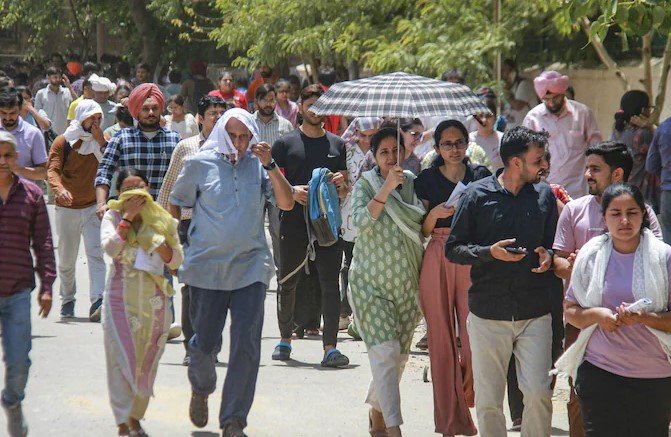The capital is in the grip of an unforgiving heatwave, with temperatures soaring, warnings piling up, and no sign of relief in sight.
Delhi turned into a furnace Monday, with the heat index touching a staggering 48.9°C—just shy of 49. The India Meteorological Department (IMD) wasted no time, slapping an orange alert across the city, warning residents to brace for more burning days ahead. Actual temperatures peaked at 43.4°C, a full 3.4 degrees higher than what Delhi usually expects in early June.
While the sun blazed down, humidity played its cruel hand too—hovering between 25% and 48%—making the city feel like it was roasting in an oven with no escape button.
Unbearable Days and Sleepless Nights Ahead
Delhiites aren’t just battling daytime extremes. Even after sunset, the heat refuses to let go.
The IMD forecasts that the capital will remain under intense heat at least till June 12. Daytime highs are expected to hover around 44°C, and nights won’t bring much comfort either. Minimum temperatures are expected to linger around 28°C, barely giving anyone a chance to cool off.
And to make matters worse? There’s barely any breeze to cut through the heat. Surface winds may clock in at 20–30 kmph, but they’re dry and hot—more like a hairdryer on full blast than a soothing gust.
Just one sentence here: Sleep? Forget about it.

Orange Alert: What It Really Means
The IMD’s orange alert isn’t just a formal announcement—it’s a wake-up call.
It’s the second-highest alert level on IMD’s warning scale. It means the weather poses a real risk to health, especially for vulnerable populations—children, the elderly, those with chronic illnesses, and outdoor workers.
The alert urges people to:
-
Avoid going out in peak afternoon hours unless absolutely necessary
-
Stay hydrated, wear light clothing, and cover the head when outdoors
-
Keep a close watch on pets, elderly family members, and infants
Hospitals have been put on standby across Delhi, as officials brace for more heatstroke and dehydration cases. Water distribution vans were spotted across several localities by evening, especially near construction sites and traffic intersections.
A Pattern of Rising Extremes
This isn’t just another hot summer. It’s part of a bigger, scarier trend.
Data from IMD shows that over the last decade, Delhi has seen a steady uptick in both the frequency and severity of heatwaves. What was once a 2- or 3-day heat spell now stretches over a week. And the peaks? They’re pushing new boundaries every year.
Notably, the real-feel temperatures—what meteorologists call the heat index—are consistently outpacing the thermometer readings. It’s not just hot. It feels unbearable.
What’s Driving This Scorch?
Experts point to a mix of long-term climate change and local urban effects.
Delhi’s “urban heat island” effect—caused by concrete, pollution, and limited green cover—traps heat and makes it worse than surrounding areas. Add to that the global warming factor, and you get a lethal combination.
Dr. Mahesh Palawat, Vice President of Meteorology at Skymet Weather, noted, “Delhi is becoming a cauldron. The dense built-up zones trap more heat. Nights are especially warmer than in nearby rural belts.”
One-liner here: The city just can’t breathe anymore.
Across North India, the Heatwave Spreads
It’s not just Delhi. Large swathes of North India are boiling.
The heatwave belt now includes Haryana, Chandigarh, parts of Punjab, Rajasthan, and western Uttar Pradesh. IMD reports from Hisar and Sirsa in Haryana clocked temperatures over 45°C on Monday.
What’s worse, many of these regions also report high dust levels and poor air quality, making it harder to even breathe comfortably. No rain is expected before June 13, IMD added.
Local governments are stepping up—schools in some districts have shut early for summer, water tankers are being sent out, and civic helplines are now heatwave-ready.
Silent Toll of the Heat
Amid all this, a chilling fact looms: we don’t actually know how many people die in these heatwaves.
India lacks a clear, centralized system to track heatwave deaths. Many fatalities go unrecorded or get misclassified under causes like cardiac arrest or dehydration. Public health experts have been raising alarms for years about this glaring data gap.
In 2015, a single heatwave killed over 2,000 people across India. Yet, current figures are hard to come by, partly because of reporting limitations, partly due to lack of awareness.
People fainting on public transport, children collapsing in school playgrounds, patients walking into hospitals with heatstroke—these aren’t isolated stories anymore. They’re part of everyday summer now.
Delhi’s Residents: Fed Up and Furious
Out on the streets, frustration is boiling over.
Ritika Jain, a retail employee working in Lajpat Nagar, shared, “We have no shade, no misting systems, nothing. It feels like we’re being cooked alive. And they expect us to smile at customers?”
At a construction site in East Delhi, workers were seen covering their heads with leftover cement sacks. “We don’t stop because we lose wages. But this heat? It’s deadly,” said Rahul, a daily wager.
Power bills are shooting up too. With ACs running nonstop and coolers humming all night, many middle-class homes are seeing their monthly energy costs double compared to March.
